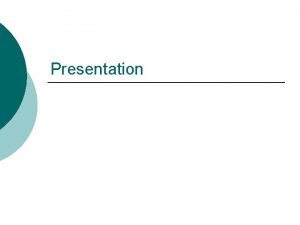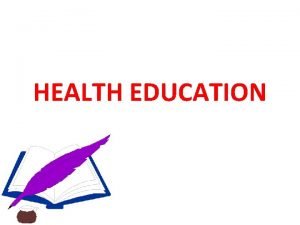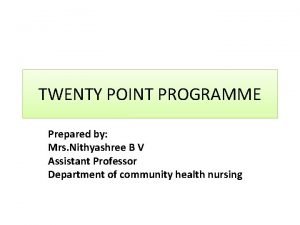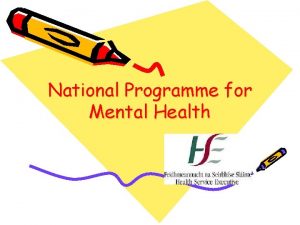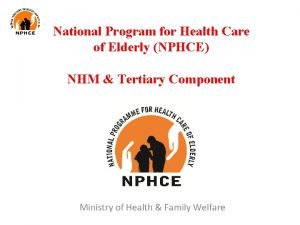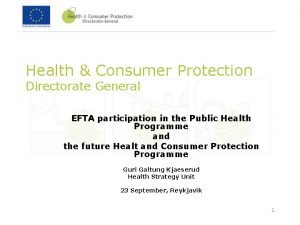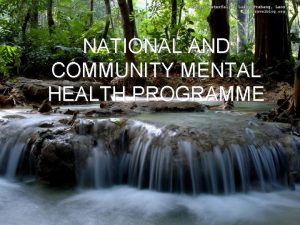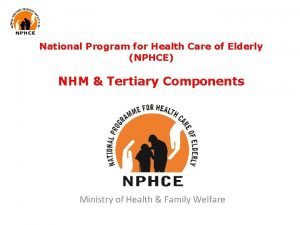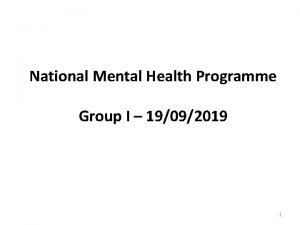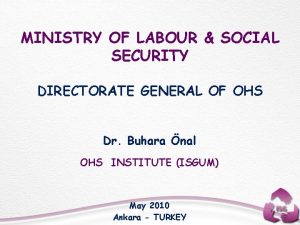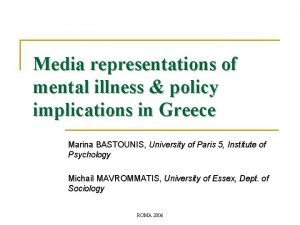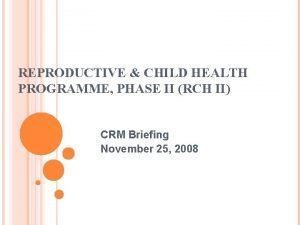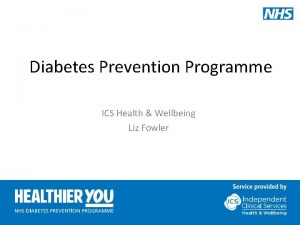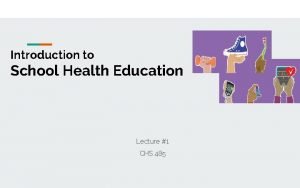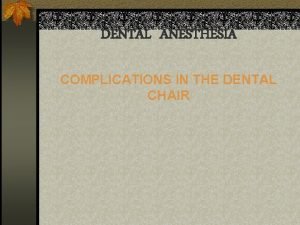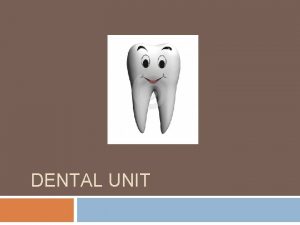GOOD MORNING SCHOOL Dental HEALTH PROGRAMME CONTENTS INTRODUCTION











































































































- Slides: 107

GOOD MORNING

SCHOOL Dental HEALTH PROGRAMME

CONTENTS Ø INTRODUCTION Ø ELEMENTS OF CONDUCTING HEALTH PROGRAMME Ø DIFFERENT PROGRAMMES SCHOOL Ø PLANNING OF PROGRAMMES SCHOOL DENTAL HEALTH 3

CONTENTS Ø ADVANTAGE PROGRAMME OF Ø DISADVANTAGE PROGRAMME SCHOOL OF SCHOOL DENTAL HEALTH Ø CONCLUSION Ø REFERENCES 4

INTRODUCTION • School often called the second home of the child, is the place where the seeds of knowledge, behavior and a pattern of living among friends and interacting with others in society is sowed. • The children attend school at such a stage when their inquisitiveness is at a high and their young brains are active enough to grab anything which comes their way. 5

INTRODUCTION • Children are particularly receptive during this period, and an ideal setting for promoting oral health. (Hiremath SS; Textbook of Preventive and Community Dentistry. 1 st Edition. Elsevier. 2007. ) • It is well known fact that the children listen to their teachers the most, hence the health education imparted through teachers is always more influential. 6

INTRODUCTION • Hence, School Dental Health Programmes were developed to impart health education through the help of teachers and in the friendlier environment of school. • Healthy oral cavity and healthy teeth are required not only for the mastication of the food but also to give a psychological strength to the personality by improving the aesthetics of the person that is also an important factor in the overall development of a child’s personality. 7

INTRODUCTION • On the other hand poor oral health has an adverse effect on the overall health of the child. • The presence of pain, difficulty in chewing, smiling and pronunciation due to missing or carious teeth have an adverse effect on the physical and psychological development of the child. • These problems can be prevented at the primordial and primary level through the School Dental Health Programmes.

HISTORY • The concept taking care of the dental health of the school children was initiated by Dr. William Fisher, a dentist of England, in late 19 th century, as he observed the fact that most of the child population is devoid of dental care and dental treatment thus has the high caries experience. • He campaigned for compulsory inspection and treatment of children in schools to provide the proper dental care and treatment to school children. 9

ESSENTIAL ELEMENTS FOR CONDUCTING SCHOOL DENTAL HEALTH PROGRAMMES • There are some important elements or steps in the organization of School dental Health Programs: Improving school - community relations Conducting regular dental inspections Conducting health education 10

ESSENTIAL ELEMENTS FOR CONDUCTING SCHOOL DENTAL HEALTH PROGRAMMES • There are some important elements or steps in the organization of School dental Health Programs: (contd…) Performing specific programmes Referral for dental care Follow-up of dental inspection 1

ESSENTIAL ELEMENTS FOR CONDUCTING SCHOOL DENTAL HEALTH PROGRAMMES 12 Improving school - community relations: formation of a community dental health council or advisory committee should include the broad representations from the parents, teachers, health officers, community leaders, administrations of the school and also the dental professionals. committees are important in improving the school community relations and make people realize the importance of dental health and the school administration’s concern in the promotion of oral health.

ESSENTIAL ELEMENTS FOR CONDUCTING SCHOOL DENTAL HEALTH PROGRAMMES Improving school - community relations: (contd…) task of these committees is to appraise and publicize the dental needs of the school children. committee should look beyond mere dental needs in terms of decayed, missing and filled, to systemic consequences of dental infection, and to the problems posed by dento-facial deformities. 13

ESSENTIAL ELEMENTS FOR CONDUCTING SCHOOL DENTAL HEALTH PROGRAMMES Conducting dental inspections:

ESSENTIAL ELEMENTS FOR CONDUCTING SCHOOL DENTAL HEALTH PROGRAMMES Conducting dental inspections: (contd…)

ESSENTIAL ELEMENTS FOR CONDUCTING SCHOOL DENTAL HEALTH PROGRAMMES Conducting dental health education: Dental health education can be conducted through 3 phases: first is to give dental health instructions, services second is to tell about the dental health the third phase is to give knowledge about dental treatment including preventive procedures. 16

ESSENTIAL ELEMENTS FOR CONDUCTING SCHOOL DENTAL HEALTH PROGRAMMES Conducting dental health education: (contd…) dental health instructions given in the classroom include: • Planning an instructional programme on the dental needs and interests of each grade group. • Planning definite teaching programme for each grade level. • Co-ordinating dental health education into the curriculum. • Continue dental health awareness through every grade. 17

ESSENTIAL ELEMENTS FOR CONDUCTING SCHOOL DENTAL HEALTH PROGRAMMES Conducting dental health education: (contd…) dentist serves as the expert resource person to strengthen the teacher's classroom instruction programme. this is important in developing proper attitudes and personal dental health practices by the teacher which can be passed on the classroom. 18

ESSENTIAL ELEMENTS FOR CONDUCTING SCHOOL DENTAL HEALTH PROGRAMMES Conducting dental health education: (contd…) self-contained dental health kit for teacher education and presentation of basic dental health concepts should be made available to every education university. (Hiremath SS; Textbook of Preventive and Community Dentistry. 1 st Edition. Elsevier. 2007. ) 19

ESSENTIAL ELEMENTS FOR CONDUCTING SCHOOL DENTAL HEALTH PROGRAMMES Conducting dental health education: (contd…) The primary goals of school oral health education is to help children develop personal lifelong skills, raise health consciousness, improve understanding and healthy attitudes to promote healthy behavior and thereby to reduce risk of oral disease. (Craft M. , Croucher R. , Dickinson J. , James M. , Clements Marylin, Rodgers A. I. ; Natural Nashers- a programme of dental health education for adolescents in schools. International Dental Journal. 1984. 34; 204213. ) 20

ESSENTIAL ELEMENTS FOR CONDUCTING SCHOOL DENTAL HEALTH PROGRAMMES Performing specific programmes: some specific programmes can be performed in the class rooms so as to make the school children able to grab the health education in more efficiently. a. Tooth brushing programmes: this plaque control programme essentially prevents upcoming gingival or periodontal problems apart from acting as a preventive programme in dental caries control. 21

ESSENTIAL ELEMENTS FOR CONDUCTING SCHOOL DENTAL HEALTH PROGRAMMES (b) Classroom-based fluoride programmes: Two effective fluoride programmes are: 1) Fluoride 'mouth - rinse' programme and 2) Fluoride tablet programme 3) Fluoridated milk (Milk fluoridation) (1) Fluoride 'mouth - rinse' programme kit used in the programme consists of fluoride rinse dispenser, cups, napkins, and plastic disposal bags. dispenser is graduated so that 2. 0 gm of packaged sodium fluoride powder can be placed in the jug and water added to the 1 OOO-ml mark.

ESSENTIAL ELEMENTS FOR CONDUCTING SCHOOL DENTAL HEALTH PROGRAMMES (1) Fluoride 'mouth - rinse' programme (contd. . ) rinse should be non-sweetened and non-flavored to discourage swallowing. Rinsing programmes are advised for grades 1 to 12 but not below. 5 ml of the rinse is dispensed into each cup and all the children are instructed to rinse the solution around the mouth for 1 minute, after which they are to spit carefully into the cup. Fluoride mouth-rinsing programmes received official recognition of safety from the FDA in 1974 and by the Council on Dental Therapeutics of the ADA in 1975. 23

ESSENTIAL ELEMENTS FOR CONDUCTING SCHOOL DENTAL HEALTH PROGRAMMES (1) Fluoride 'mouth - rinse' programme (contd. . ) Aside from the United States, 7 other nations. Denmark, Finland, New Zealand, Netherlands, Norway, Thailand Sweden - support major mouth rinse programmes. (2) Fluoride tablet programme: use of fluoride tablets in schools is a method of administering systemic fluoride to children. self applied fluoride regimen is for use only and communities in which the water supply is fluoride deficient. 24

ESSENTIAL ELEMENTS FOR CONDUCTING SCHOOL DENTAL HEALTH PROGRAMMES (2) Fluoride tablet programme: (contd. . ) All children who participate in self-applied fluoride programmes must have parental consent. a classroom teacher who has been trained to supervise the procedure first dispenses a fluoride tablets to the participating students. One tablet is given to each students then chew, swish the 2. 2 mg sodium fluoride (1 mg fluoride) around the mouth for a minute and then swallow. 25

ESSENTIAL ELEMENTS FOR CONDUCTING SCHOOL DENTAL HEALTH PROGRAMMES (2) Fluoride tablet programme: (contd. . ) swish-and-swallow technique provides the benefits of a topical application, it also provides the optimum systemic benefits of fluoride ingestion that occur during the period of tooth development and maturation. daily tablet is more effective than the weekly rinse. 26

ESSENTIAL ELEMENTS FOR CONDUCTING SCHOOL DENTAL HEALTH PROGRAMMES (2) Fluoride tablet programme: (contd. . ) Advantages Easy to perform Both systemic and topical benefits. Less time consuming Disadvantages Daily procedure 27

ESSENTIAL ELEMENTS FOR CONDUCTING SCHOOL DENTAL HEALTH PROGRAMMES (3) Fluoridated milk (Milk fluoridation): use of fluoridated milk for dental caries prevention was first proposed by Zeigler in 1953. method was tested in a number of countries in the late 1950 s, particularly in Australia, Germany, Japan, Switzerland, and the United States. this preventive programme not only ensures that children receive milk on a daily basis, but that they have the added advantage of fluoride exposure to protect their teeth against dental caries. 28

ESSENTIAL ELEMENTS FOR CONDUCTING SCHOOL DENTAL HEALTH PROGRAMMES (3) Fluoridated milk (Milk fluoridation): [contd. . ] In 1986 the World Health Organization and the Borrow Dental Milk Foundation decided to extend the implementation of milk fluoridation to community-level projects. The use of school milk as a vehicle for fluoride in a dental public health programme has an important attraction of the fact that milk forms an important part of children’s diets. 29

ESSENTIAL ELEMENTS FOR CONDUCTING SCHOOL DENTAL HEALTH PROGRAMMES (4) School water fluoridation programmes: DEFINITION: It is defined as upward adjustment of fluoride ion concentration in a school drinking water supply to optimum level for prevention of dental caries, considered at present to be four and one halftimes the recommended level of community fluoridation. School water fluoridation is used when the school has an independent water supply, usually in consolidated rural schools. Consolidated rural schools are ideal for this approach because all grades from kindergarten through 12 are housed in the same complex using one water. source.

ESSENTIAL ELEMENTS FOR CONDUCTING SCHOOL DENTAL HEALTH PROGRAMMES (4) School water fluoridation programmes: (contd. . ) In 1954, a school water fluoridation pilot study was initiated at St. Thomas V. S. Virgin Islands, by the U. S Public Health Service division of dental health. 31

ESSENTIAL ELEMENTS FOR CONDUCTING SCHOOL DENTAL HEALTH PROGRAMMES (4) School water fluoridation programmes: (contd. . ) In Pike country, Kentucky, the water supplies of 2 schools were fluoridated at 3. 3 times the optimum and Ilk lake, Pennsylvania, the water supply of one school was fluoridated at 4. 5 times the optimum recommended level for that area. After 8 years, the children who had attended the study schools had 32. 8% (Pike Country) and 33. 9% (Ilk Lake) less caries experience than students who had attended school prior fluoridation. (Peter Soben; Essentials of Preventive and Community Dentistry. 3 rd Edition. Arya (Medi) Publishing House. 2007. )

ESSENTIAL ELEMENTS FOR CONDUCTING SCHOOL DENTAL HEALTH PROGRAMMES (4) School water fluoridation programmes: (contd. . ) School water was fluoridated to provide maximum cariostatic effect in developing teeth. Since children spend only 6 to 8 hours in school, concentration of fluoride 4 to 6 times more than that designated for community water, was recommended. 33

ESSENTIAL ELEMENTS FOR CONDUCTING SCHOOL DENTAL HEALTH PROGRAMMES (4) School water fluoridation programmes: (contd. . ) Advantage: Results of several school water fluoridation programs indicate that it can be an effective public health measure to reduce dental caries in communities where fluoridation of centralized water supply is not possible. 34

ESSENTIAL ELEMENTS FOR CONDUCTING SCHOOL DENTAL HEALTH PROGRAMMES (4) School water fluoridation programmes: (contd. . ) Disadvantages: Most of the children are 5 to 6 years old when starting school, at this age their dental development precludes the fluoride from school water fluoridation and well not provide pre eruptivecontact to primary teeth. It allows only pre - eruptive protection benefits to primary teeth. Only few schools might be able to afford initial installation cost, supplies and maintenance. 35

ESSENTIAL ELEMENTS FOR CONDUCTING SCHOOL DENTAL HEALTH PROGRAMMES (4) School water fluoridation programmes: (contd. . ) Disadvantages: Benefits are only for those who attend the school. Major disadvantage- children do not receive benefits until they begin school 36

ESSENTIAL ELEMENTS FOR CONDUCTING SCHOOL DENTAL HEALTH PROGRAMMES Sealants placement:

ESSENTIAL ELEMENTS FOR CONDUCTING SCHOOL DENTAL HEALTH PROGRAMMES Referral for dental care: In a few schools dental care is provided at the school itself. Many schools where there is no aid for such programme have to refer the children to the dentist of their choice for proper dental treatment. 38

ESSENTIAL ELEMENTS FOR CONDUCTING SCHOOL DENTAL HEALTH PROGRAMMES The concept of ‘blanket' referral In this programme, all children are given referral cards to take home and subsequently to the dentist, who sign the cards upon completion of examination, treatment, or both. The signed cards are then returned to the school nurse, or classroom teacher, who plays an important role in following up the referrals with the child and parents. 39

ESSENTIAL ELEMENTS FOR CONDUCTING SCHOOL DENTAL HEALTH PROGRAMMES Follow-up of dental inspection: The mere issuance of referral slips to children following dental inspection will be of little value if steps are not taken to make it clear that the school is interested in defect correction. This needs a good follow-up system. 40

ESSENTIAL ELEMENTS FOR CONDUCTING SCHOOL DENTAL HEALTH PROGRAMMES Follow-up of dental inspection: (contd. . ) The dental hygienist is the logical person to conduct such follow-up examinations. Classroom teachers can also do this work, but it is important that someone from the school health services co-ordinate the efforts of the various teachers and make such additional contacts as may be necessary with the parents of the children. (Peter Soben; Essentials of Preventive and Community Dentistry. 3 rd Edition. Arya (Medi) Publishing House. 2007. ) 41

DIFFERENT SCHOOL DENTAL HEALTH PROGRAMMES Ø A wide variety of dental health education programmes have been successfully conducted in many of the western countries. Ø School based programme can be categorized in 2 types. Educational – Learning about your oral health, Tattletooth, North Carolina statewide programme, New Zealand Programme, Demonstrative. Askov

DIFFERENT SCHOOL DENTAL HEALTH PROGRAMMES LEARNING ABOUT YOUR ORAL HEALTH- a prevention oriented school programme: Ø This programme was developed by the 'American Dental Association' (ADA) and their consultants in coordination with the 1971 ADA House of delegates and is presently available to school systems throughout the United States of America. Ø The primary goal of this programme is to develop the knowledge, skills and attitudes needed for prevention of dental diseases. Ø The main aim of the programme is to develop adequate plaque control skills and knowledge among the school

DIFFERENT SCHOOL DENTAL HEALTH PROGRAMMES LEARNING ABOUT YOUR ORAL HEALTH- a prevention oriented school programme: • other topics included in this programme are the significance of fluoride, oral safety, consumer health concepts, the role of dental professionals, and the relationship of oral health with total health. 44

DIFFERENT SCHOOL DENTAL HEALTH PROGRAMMES LEARNING ABOUT YOUR ORAL HEALTH- a prevention oriented school programme: • Implementation of the programme: The programme is divided into five levels, each level having its own defined specific content. The five different levels are; Preschool (designed for children too young to read). Level I (kindergarten through grade 3). Level II (grades 4 through 6). 45

DIFFERENT SCHOOL DENTAL HEALTH PROGRAMMES LEARNING ABOUT YOUR ORAL HEALTH- a prevention oriented school programme: • Implementation of the programme: Level III (grades 7 through 9). Level IV (grades 10 through 12). Ø The ADA in collaboration with the American Cancer Society has developed materials for educating junior and senior high school students to make them aware of the hazards of tobacco usage. 46

DIFFERENT SCHOOL DENTAL HEALTH PROGRAMMES TEXAS STATEWIDE PREVENTIVE DENTISTRY PROGRAMME "TATTLETOOTH PROGRAMME" Ø The Tattletooth Programme was developed in 1974 -1976 as a cooperative effort between health professional organizations, the Texas Department of Health and the Texas Education Agency through a grant from the Department of Health and Human Services to the Bureau of Dental Health. Ø The programme was pilot tested in 1975, field tested in spring 1976 to schools within the state of Texas.

DIFFERENT SCHOOL DENTAL HEALTH PROGRAMMES TEXAS STATEWIDE PREVENTIVE DENTISTRY PROGRAMME "TATTLETOOTH PROGRAMME" Ø In 1985, the Texas legislature mandated that the essential elements for comprehensive health education curricula identified in the School Health Education Evaluation Project be incorporated into the curriculum statewide and be taught to the state's school children. Ø This legislative action stimulated a need for the Tattle tooth Programme statewide. 48

DIFFERENT SCHOOL DENTAL HEALTH PROGRAMMES TEXAS STATEWIDE PREVENTIVE DENTISTRY PROGRAMME "TATTLE TOOTH PROGRAMME" Ø A new programme underwent formative evaluation in the spring of 1988. In 1989, the Bureau of dental health developed a mostly new programme, Tattle tooth II, A New Generation for Grades K-6, so named because the characters in the artwork for grade kindergarten through second were from the old curriculum. Ø Separate lesson plans were developed for each grade and a systems approach was used to develop all educational material.

DIFFERENT SCHOOL DENTAL HEALTH PROGRAMMES TEXAS STATEWIDE PREVENTIVE DENTISTRY PROGRAMME "TATTLE TOOTH PROGRAMME" Ø Three videotapes were produced as part of the teachertraining package: The first videotape familiarizes the teachers with the lesson format and content. A second videotape, "Brushing and Flossing" was developed for the dual purpose of teacher training and as an educational unit to be used by the teacher with the students. 50

DIFFERENT SCHOOL DENTAL HEALTH PROGRAMMES TEXAS STATEWIDE PREVENTIVE DENTISTRY PROGRAMME "TATTLE TOOTH PROGRAMME" A third videotape provides teachers with additional background information as a means of preparing them to teach the lessons. 51

DIFFERENT SCHOOL DENTAL HEALTH PROGRAMMES TEXAS STATEWIDE PREVENTIVE DENTISTRY PROGRAMME "TATTLE TOOTH PROGRAMME“ Programme philosophy and goals: Ø The basic goal of the programme is to reduce dental disease and develop positive dental habits to last a lifetime. The major thrust of Tattle tooth is to convince students that preventing dental disease is important and that they can do it. 52

DIFFERENT SCHOOL DENTAL HEALTH PROGRAMMES TEXAS STATEWIDE PREVENTIVE DENTISTRY PROGRAMME "TATTLE TOOTH PROGRAMME“ Programme philosophy and goals: Ø The programme embraces the six elements of effective lesson design; anticipatory set, setting the objective, input modeling, checking for understanding, guided practice and independent practice. 53

DIFFERENT SCHOOL DENTAL HEALTH PROGRAMMES TEXAS STATEWIDE PREVENTIVE DENTISTRY PROGRAMME "TATTLE TOOTH PROGRAMME“ Programme implementation Ø The Texas Department of Health employs 16 hygienists in the eight public health regions to implement the Tattle tooth Programme. Ø The hygienists instruct teachers using videotapes designed for teacher training and provide them with a copy of the curriculum. 54

DIFFERENT SCHOOL DENTAL HEALTH PROGRAMMES TEXAS STATEWIDE PREVENTIVE DENTISTRY PROGRAMME "TATTLE TOOTH PROGRAMME“ Programme implementation Ø Topics covered in the curriculum include correct brushing and flossing techniques, awareness of the importance of safety and factual information relating to dental disease, its causes and preventive techniques. 55

DIFFERENT SCHOOL DENTAL HEALTH PROGRAMMES TEXAS STATEWIDE PREVENTIVE DENTISTRY PROGRAMME "TATTLE TOOTH PROGRAMME“ Programme evaluation Ø A major field test conducted in 1975 and 1976 studied 15, 000 children in 18 educational service regions. Ø Results of single exposure to the programme revealed that dental health knowledge was significantly increased at all grade levels. Plaque levels were decreased by approximately 15% in a randomly selected sample of 2, 142 children. 56

DIFFERENT SCHOOL DENTAL HEALTH PROGRAMMES TEXAS STATEWIDE PREVENTIVE DENTISTRY PROGRAMME "TATTLE TOOTH PROGRAMME“ Programme evaluation Ø Over 80% of the teachers judged the programme to be helpful and effective, but evaluation questions suggested that they felt a need for additional technical help in brushing and flossing. 57

DIFFERENT SCHOOL DENTAL HEALTH PROGRAMMES TEXAS STATEWIDE PREVENTIVE DENTISTRY PROGRAMME "TATTLE TOOTH PROGRAMME“ Programme evaluation Ø The evaluation of the Tattle tooth Programme in 1977 and 1978 had three major goals: To conduct a gross dental screening to obtain an estimate of the prevalence of dental problems and to provide other base -rate data. To conduct an experimental study of dental awareness involving a pre- and post- examination design and,

DIFFERENT SCHOOL DENTAL HEALTH PROGRAMMES TEXAS STATEWIDE PREVENTIVE DENTISTRY PROGRAMME "TATTLE TOOTH PROGRAMME“ Programme evaluation Ø The evaluation of the Tattle tooth Programme in 1977 and 1978 had three major goals: (contd. . ) To conduct an evaluation of the services provided by trained dental hygienists to determine whether or not the technical help previously requested by participating teachers was provided. 59

DIFFERENT SCHOOL DENTAL HEALTH PROGRAMMES NORTH CAROLINA STATEWIDE PREVENTIVE DENTAL HEALTH PROGRAMME: Ø In 1970, the North Carolina Dental Society passed resolutions advocating a strong preventive dental disease program embracing school and community fluoridation, fluoride treatments for school children, continuing education on prevention for dental professionals and plaque control education in schools and communities. 60

DIFFERENT SCHOOL DENTAL HEALTH PROGRAMMES NORTH CAROLINA STATEWIDE PREVENTIVE DENTAL HEALTH PROGRAMME: • In 1973, Frank. E. Law prepared a report for the North Carolina Dental Society that defined the extent of the dental disease problem and resulted in the initiation of a 1 O-year program to reduce dental disease. • The 10 -year preventive dentistry plan had the approval and support of the North Carolina General Assembly. • This was the first statewide programme of its magnitude and remains the largest and most comprehensive of all state public health programmes.

DIFFERENT SCHOOL DENTAL HEALTH PROGRAMMES NORTH CAROLINA STATEWIDE PREVENTIVE DENTAL HEALTH PROGRAMME: Programme philosophy and goals: North Carolina Dental Public Health programme is a unique public and private partnership dedicated to the mission of assuring conditions in which North Carolina citizens can achieve optimal oral health. The majority of the staff, public health dentists and dental hygienists are located in the counties to provide services through local health departments. 62

DIFFERENT SCHOOL DENTAL HEALTH PROGRAMMES NORTH CAROLINA STATEWIDE PREVENTIVE DENTAL HEALTH PROGRAMME: Programme philosophy and goals: All programme activities include educational components to modify the behavior patterns of individuals to improve their oral health habits through dietary changes, tooth brushing and flossing. Young children are the primary focus for education because the earlier a child is reached, the greater the potential for positively affecting the child's attitudes, values and behavior. 63

DIFFERENT SCHOOL DENTAL HEALTH PROGRAMMES NORTH CAROLINA STATEWIDE PREVENTIVE DENTAL HEALTH PROGRAMME: Programme implementation: This programme is unique in that, it is designed to reach several segments of the population: young children, parents, teachers, dental professionals and community leaders. In the year 1990, services delivered through the programme included the fluoridation of water supplies of 130 rural schools, weekly fluoride mouth rinse for more than 416, 000 students in 1, 051 schools and screening and referral for more than 339, 000 children.

DIFFERENT SCHOOL DENTAL HEALTH PROGRAMMES NORTH CAROLINA STATEWIDE PREVENTIVE DENTAL HEALTH PROGRAMME: Programme implementation: Dental health education was presented to 361, 000 children and 42, 000 adults. More than 33, 000 dental sealants were applied. To reach children, public health dental staff provide training and consultation to those who work with preschool and school-age children and maternal and child health programs, for example, elementary school teachers, health department staff and parents. 65

DIFFERENT SCHOOL DENTAL HEALTH PROGRAMMES NORTH CAROLINA STATEWIDE PREVENTIVE DENTAL HEALTH PROGRAMME: Programme implementation: Several additional teaching aids are available, such as more than 50 different leaflets, worksheets and handouts on nutrition, fluoride, plaque control, routine dental visits, injury prevention and smokeless tobacco. 66

DIFFERENT SCHOOL DENTAL HEALTH PROGRAMMES New Zealand programme: Ø The New Zealand School Dental Service Plan has been successful in influencing parents to enroll their children 'before reaching school age' and in persuading children to attend cheerfully and accept the required treatment. Ø The importance of early care has been stressed. For more than 25 years, promotion of the use of the services by preschool children has been a primary health education objective. 67

DIFFERENT SCHOOL DENTAL HEALTH PROGRAMMES ASKOV DENTAL DEMONSTRATION: Ø Askov is a small farming community with a population mostly of Danish extraction. Ø It showed very high dental caries in the initial surveys made in 1943 and 1946. Ø During the period from 1949 to 1957, the Section on Dental Health of the Minnesota Department of Health supervised a demonstration school dental health programme in Askov, including caries prevention and control, dental health education and dental care. 68

DIFFERENT SCHOOL DENTAL HEALTH PROGRAMMES ASKOV DENTAL DEMONSTRATION: Ø All recognized methods for preventing dental caries were used in the demonstration with the exception of communal water fluoridation. Ø Dental care was rendered by a group of five dentists from nearby communities employed by the Minnesota Department of Health. Ø Topical fluoride applications were also provided by the team of dentists.

DIFFERENT SCHOOL DENTAL HEALTH PROGRAMMES ASKOV DENTAL DEMONSTRATION: Findings of this programme through a 10 year period: 28% reduction in dental caries in deciduous teeth of children aged 3 to 5 years. 34% reduction in caries in the permanent teeth of children 6 to 12 years old. 14% reduction in permanent teeth of children 13 to 17 years old. 70

DIFFERENT SCHOOL DENTAL HEALTH PROGRAMMES ASKOV DENTAL DEMONSTRATION: Findings of this programme through a 10 year period: there were improvements in filled-tooth ratios and many intangible benefits such as good health and dietary habits for the children to carry on to adult life. 71

DIFFERENT SCHOOL DENTAL HEALTH PROGRAMMES Preschool Dental Health Programme: Ø Preschool children can be reached through department of health baby clinics, necessary schools, day-care centers, and kindergarten classes. Ø In 1965, Head Start, a national preschool programme, was initiated in U. S. under the Economic Opportunity Act of 1964 to provide early learning experiences to poor and underprivileged children. 72

DIFFERENT SCHOOL DENTAL HEALTH PROGRAMMES SCHOOL HEALTH: ADDITIONAL REFERRAL PROGRAMME (SHARP): (Motivation through Home Visits) Ø A programme called SHARP was instituted in Philadelphia where the lowest rate for correction of physical defects prevailed. Ø The purpose of the programme was to motivate parents into initiating action for correction of defects in their children through effective utilization of community resources. 73

DIFFERENT SCHOOL DENTAL HEALTH PROGRAMMES SCHOOL HEALTH: ADDITIONAL REFERRAL PROGRAMME (SHARP): (Motivation through Home Visits) Ø The project was carried out by the district nurses with the cooperation of all school personnel. Ø The nurses made daytime visits to families in which the mothers were at home. Ø Working parents were contacted by phone. 74

DIFFERENT SCHOOL DENTAL HEALTH PROGRAMMES SCHOOL HEALTH: ADDITIONAL REFERRAL PROGRAMME (SHARP): (Motivation through Home Visits) Ø The one-to-one basis of health guidance between parent and health worker establishes better rapport between school and home. (WHO INFORMATION SERIES ON SCHOOL HEALTH. Document Eleven. Oral Health Promotion: An Essential Element of a Health-Promoting School. 2003. ) 75

PLANNING A SCHOOL DENTAL HEALTH PROGRAMMES Planning of School Dental Health Programme is done under following points: Establishing or involving a school health team and a community advisory committee. Conducting a situation analysis. Obtaining source of data. Establishing commitment and policies. 76

PLANNING A SCHOOL DENTAL HEALTH PROGRAMMES Planning of School Dental Health Programme is done under following points: (contd. . ) Establishing supportive school policies/ practices. Obtaining parental support and commitment. Setting goals and objectives. 77

PLANNING A SCHOOL DENTAL HEALTH PROGRAMMES ESTABLISHING OR INVOLVING A SCHOOL HEALTH TEAM AND A COMMUNITY ADVISORY COMMITTEE: School Health Team: Ø School health team is a designated group of people who are committed to work together to promote the health of all people who are working and learning at school. 78

PLANNING A SCHOOL DENTAL HEALTH PROGRAMMES 1. ESTABLISHING OR INVOLVING A SCHOOL HEALTH TEAM AND A COMMUNITY ADVISORY COMMITTEE: School Health Team: Ø Depending on local cir cumstances, it should comprise a balance of representa tives, including students, parents, school governors, teachers and school staff: members of teachers' repre sentativeorganizations, Parent Teacher Association (PTA) representatives, administrators, food service providers, and health care providers. Ideally, school health team should have between 8 and 14 members.

PLANNING A SCHOOL DENTAL HEALTH PROGRAMMES 1. ESTABLISHING OR INVOLVING A SCHOOL HEALTH TEAM AND A COMMUNITY ADVISORY COMMITTEE: School Health Team: Ø The team is responsible for the management, co ordinationand monitoring of health promotion policies and action plans, and for establishing links with district education personnel, local health officials and provincial or national network or ministry-level staff. 80

PLANNING A SCHOOL DENTAL HEALTH PROGRAMMES 1. ESTABLISHING OR INVOLVING A SCHOOL HEALTH TEAM AND A COMMUNITY ADVISORY COMMITTEE: Ø Community involvement in the proposed programme is essential for garnering greater acceptance and support of the programme and in helping to ensure its ultimate success. 81

PLANNING A SCHOOL DENTAL HEALTH PROGRAMMES 1. ESTABLISHING OR INVOLVING A SCHOOL HEALTH TEAM AND A COMMUNITY ADVISORY COMMITTEE: Ø Involvement of individuals representing different constituencies within the community (e. g. dental health professionals, parents, school administrators and teachers, local health department, local governing body, community health centers, local service organizations) is seeked to provide assistance in obtaining community input and support and in serving as members of an advisory committee.

PLANNING A SCHOOL DENTAL HEALTH PROGRAMMES 1. ESTABLISHING OR INVOLVING A SCHOOL HEALTH TEAM AND A COMMUNITY ADVISORY COMMITTEE: Ø The advisory committee should be briefed on the findings from the community needs assessment, the scope of the problem, and plans to establish schoolbased dental services. Ø It is important to elicit the support of advisory committee members in providing assistance in program planning and implementation, oversight of the dental services, and in obtaining community input.

PLANNING A SCHOOL DENTAL HEALTH PROGRAMMES 2. CONDUCTING A SITUATION ANALYSIS: Ø The aim of the situation analysis is to assess the needs, resources and conditions that are relevant to the plan ning and development of a health promoting school. Ø The information needed include: Current health and oral health status of children and adolescents. Behaviors and other key factors related to oral health and disease.

PLANNING A SCHOOL DENTAL HEALTH PROGRAMMES 2. CONDUCTING A SITUATION ANALYSIS: Ø The information needed include: Oral health believes knowledge, attitudes and behaviors. Other socio environmental factors that have an impact on oral health. 85

PLANNING A SCHOOL DENTAL HEALTH PROGRAMMES 2. CONDUCTING A SITUATION ANALYSIS: Ø The information needed include: Existing programmes and activities in school and local community, as well as those delivered by the health service providers. Available resources in school and the community. 86

PLANNING A SCHOOL DENTAL HEALTH PROGRAMMES 3. OBTAINING SOURCE OF DATA: It is more efficient to use readily available existing data than to undertake a new survey. The quality of data must be carefully examined since data are often collected for other purposes than planning Health-Promoting Schools. It is also important to collaborate with health, education and other government departments and community organizations effectively to avoid duplication of efforts. 87

PLANNING A SCHOOL DENTAL HEALTH PROGRAMMES 3. OBTAINING SOURCE OF DATA: The following may be the sources of the dataa. School records, observations, questionnaires to stu dents, school staff, parents and local organizations. b. Data from health authorities; a checklist of services available in the school, and the types and frequency of activities. c. Sample survey of community members; focused group discussion with community leaders. 88

PLANNING A SCHOOL DENTAL HEALTH PROGRAMMES 3. OBTAINING SOURCE OF DATA: The following may be the sources of the datad. Review of school records and timetable. e. Observations, structured questionnaires or check list, types and quality of food and drinks in the canteen/mobile snack shop, and vending machines around the school premises. 89

PLANNING A SCHOOL DENTAL HEALTH PROGRAMMES 4. ESTABLISHING COMMITMENT AND POLICIES: Commitment and support of relevant government departments, particularly health and education authorities are imperative. The success of oral health promotion interventions also depends on the dedica tion and involvement of students, parents, teachers and community and business organizations. Responsibility must be shared among students, family, school, health professionals, government and the community.

PLANNING A SCHOOL DENTAL HEALTH PROGRAMMES 5. ESTABLISHING SUPPORTIVE SCHOOL POLICIES/ PRACTICES: Policies should be brief and simple documents that provide a supportive frame work detailing the rationale, objectives and guidelines for the development, implementation and evaluation of oral health promotion activities in schools made available. If preferred, a single policy document that covers all elements, areas and activities of a health promoting school can be developed.

PLANNING A SCHOOL DENTAL HEALTH PROGRAMMES 6. OBTAINING PARENTAL SUPPORT AND COMMITMENT: Parents influence their children's oral health directly by providing a home environment that is conducive to oral health. Their input in monitoring children's oral hygiene practices and dietary behaviors at home is paramount. 92

PLANNING A SCHOOL DENTAL HEALTH PROGRAMMES 6. OBTAINING PARENTAL SUPPORT AND COMMITMENT: Parents and other signifi cantfamily members should be educated about the importance of oral health, encouraged to take an active role in their children's oral health, reinforcing and complementing school efforts to promote good oral health behaviors, and conditions that reduce the risk of oral diseases. 93

PLANNING A SCHOOL DENTAL HEALTH PROGRAMMES 7. SETTING GOALS AND OBJECTIVES: To provide a physical, organizational and psychoso cial school environment that is conducive to oral health of students, teachers and school staff, as well as families and the community. To reduce the risk factors associated with oral health. To improve oral health knowledge and attitudes. 94

PLANNING A SCHOOL DENTAL HEALTH PROGRAMMES 7. SETTING GOALS AND OBJECTIVES: Ø To develop skills and behaviors for good oral health comprehensive school programmes should include: Healthy school environment School health education. School health services. Nutrition and food services. 95

PLANNING A SCHOOL DENTAL HEALTH PROGRAMMES 7. SETTING GOALS AND OBJECTIVES: Ø To develop skills and behaviors for good oral health comprehensive school programmes should include: (contd. . ) Physical education and sport. Mental health and wellbeing. Health promotion for school staff and School and community relationships and collaboration. 96

ADVANTAGES OF SCHOOL DENTAL HEALTH PROGRAMMES Ø The school based dental clinics can bring comprehensive dental care including preventive measures to schoolchildren where they are gathered anyway for non dental reasons in the largest possible numbers. Ø This is particularly advantageous in dentist - deprived areas. Ø A combination of education and health facilities is sensible both ideologically and logistically. 97

ADVANTAGES OF SCHOOL DENTAL HEALTH PROGRAMMES Ø School based dental clinics are less threatening to children than are private offices, since the children are in familiar surroundings. Ø In addition, the children's daily contact with the dental personnel in other roles, such as joining with the teachers in a variety of school activities, may have a lasting effect in their attitudes towards dentistry in general. Ø Members of the dental health team can easily engage in classroom teaching and then reinforce their messages by individual instructions at chairside.

ADVANTAGES OF SCHOOL DENTAL HEALTH PROGRAMMES Ø By providing certain basic dental services at government expense, low-income people are more likely to be able to afford private dental care of a specialized nature when necessary. Ø School - based dental clinics provide an ideal setting for the use of the expanded duty dental auxiliaries or therapists or dental nurses types. Ø School - based dental clinics give an opportunity for part time or full time employment of dentists at varying ages.

ADVANTAGES OF SCHOOL DENTAL HEALTH PROGRAMMES Ø School - based dental clinics in general facilitate peer review, either at the informal level or where instituted formally as a part of government service. Ø School - based dental clinics and other dental clinics, when associated with medical clinics, can facilitate valuable consultation on medico - dental problems. (Peter Soben; Essentials of Preventive and Community Dentistry. 3 rd Edition. Arya (Medi) Publishing House. 2007. ) 100

DISADVANTAGES OF SCHOOL BASED DENTAL CLINICS Ø One-chair clinics, commonly seen in the older school dental programmes, have proved insufficient for the same reasons that one-chair solo private dental practice has proved inefficient. Ø The short school hours and the long school vacations have made full-time employment of personnel difficult in the United States, although Australia reports of no such problem. 101

CONCLUSION Ø School Health Education is a new area of expanding interest and activity, a focus for national concern and the development of projects. Ø The scientific literature relating to health education is rapidly growing and many schools are actively planning health education courses. Ø Focusing on this major percentage of child population which can be found on a single place that is school, School Dental Health Programme is a minor budgetary programme in most dental health care systems throughout the world.

CONCLUSION Ø Appropriate educational programmes on school dental health will improve the knowledge and attitude of children forming the foundation for improvements for future higher health goals. (Craft M. , Croucher R. , Dickinson J. , James M. , Clements Marylin, Rodgers A. I. ; Natural Nashers- a programme of dental health education for adolescents in schools. International Dental Journal. 1984. 34; 204213. ) 103

CONCLUSION Ø At the global level approximately 80% of children attend primary schools and 60% complete at least 4 years of education with wide variations between countries and gender. (Hiremath SS; Textbook of Preventive and Community Dentistry. 1 st Edition. Elsevier. 2007) Ø It is an important branch of community health programme. It is economical and powerful means of raising community health in future generations. 104

REFERENCES Ø Hiremath SS; Textbook of Preventive and Community Dentistry. 1 st Edition. Elsevier. 2007. Ø Craft M. , Croucher R. , Dickinson J. , James M. , Clements Marylin, Rodgers A. I. ; Natural Nashers- a programme of dental health education for adolescents in schools. International Dental Journal. 1984. 34; 204213. Ø Peter Soben; Essentials of Preventive and Community Dentistry. 3 rd Edition. Arya (Medi) Publishing House. 2007.

REFERENCES Ø WHO INFORMATION SERIES ON SCHOOL HEALTH. Document Eleven. Oral Health Promotion: An Essential Element of a Health-Promoting School. 2003. Ø Jones RB. The school based dental care system of New Zealand South Australia: a decade change. Journal of Public Health Dentistry 1984; 44: 120 -124. Ø Friedman JW. New Zealand School dental service. Journal of American Dental Association 1972; 85: 609617.

THANK YOU
 Buenas tardes
Buenas tardes Teacher:good morning class
Teacher:good morning class Good evening students
Good evening students Good morning everyone vs everybody
Good morning everyone vs everybody Hello friend! i am glad to see you!
Hello friend! i am glad to see you! Hi good afternoon google
Hi good afternoon google Good afternoon students
Good afternoon students Formal greeting and responses
Formal greeting and responses Good day ladies and gentlemen
Good day ladies and gentlemen Punktualizmus
Punktualizmus Good morning good lookin
Good morning good lookin Good morning, students
Good morning, students Good evening ladies and gentlemen. we are now
Good evening ladies and gentlemen. we are now School health programme
School health programme Minus desk in community medicine
Minus desk in community medicine Objectives of school health programme
Objectives of school health programme Good morning student how are you
Good morning student how are you Good morning my lovely students
Good morning my lovely students That's all of my presentation
That's all of my presentation Good morning and welcome
Good morning and welcome Good morning public school
Good morning public school Good morning class
Good morning class Good thoughts good deeds good words
Good thoughts good deeds good words You are good when theres nothing good in me
You are good when theres nothing good in me Healthy education definition
Healthy education definition Contents introduction
Contents introduction No one loves me
No one loves me Are you sleeping brother john
Are you sleeping brother john School magazine cover page
School magazine cover page 20 points program ppt
20 points program ppt Objectives of rch
Objectives of rch National health intervention program for mother and child
National health intervention program for mother and child Mental health programme
Mental health programme National program for healthcare of elderly
National program for healthcare of elderly National health programme
National health programme National health programme
National health programme Objectives of community mental health
Objectives of community mental health Nphce logo
Nphce logo National mental health programme
National mental health programme Conclusion for safety and health
Conclusion for safety and health Conclusion of health and disease
Conclusion of health and disease Role of nurse in rch phase 2
Role of nurse in rch phase 2 Ics health & wellbeing
Ics health & wellbeing Introduction of school health services
Introduction of school health services Introduction for cultural programme
Introduction for cultural programme Pitlochry primary school online programme
Pitlochry primary school online programme Pitlochry primary school online programme
Pitlochry primary school online programme Pitlochry primary school online programme
Pitlochry primary school online programme Art elective programme
Art elective programme Gesegde onderwerp en voorwerp
Gesegde onderwerp en voorwerp Www.shaala siddhi.nuepa.org.in login
Www.shaala siddhi.nuepa.org.in login School readiness programme in kvs
School readiness programme in kvs Morning to you song
Morning to you song Good morning reported speech
Good morning reported speech Receptionist good morning
Receptionist good morning Ohio good morning
Ohio good morning Good morning 1 june
Good morning 1 june Good morning ladies
Good morning ladies Unit 1 good morning
Unit 1 good morning Good evening i hope you are fine
Good evening i hope you are fine Good morning welcome june
Good morning welcome june Good morning campers today's challenge is simple
Good morning campers today's challenge is simple Good morning one and all
Good morning one and all Good morning class how are you today
Good morning class how are you today Good morning flashcards
Good morning flashcards Good morning please have a seat
Good morning please have a seat Good morning please have a seat
Good morning please have a seat Thank you french
Thank you french Good morning florence
Good morning florence Good morning in science language
Good morning in science language Good morning dear students
Good morning dear students Good morning class!
Good morning class! Appendices epiploicae
Appendices epiploicae Good morning boys and girls
Good morning boys and girls Good morning, boys
Good morning, boys Good morning lenin
Good morning lenin Good morning madam. what's the problem
Good morning madam. what's the problem Lenore hetrick photo
Lenore hetrick photo Assalamu alaikum good morning
Assalamu alaikum good morning Mad libs nouns only
Mad libs nouns only Stay home stay safe good morning
Stay home stay safe good morning Good morning welcome back
Good morning welcome back Thank you bella
Thank you bella Good morning formal
Good morning formal Hello good morning students
Hello good morning students Good morning students how are you today
Good morning students how are you today Good morning hr
Good morning hr Cat poem with rhyming words
Cat poem with rhyming words Morning jobs
Morning jobs Teacher good morning everybody
Teacher good morning everybody Good morning poetry
Good morning poetry Good morning elves
Good morning elves Good morning elves
Good morning elves Data access worldwide
Data access worldwide Desperate man painting
Desperate man painting What is his name
What is his name Good morning investors
Good morning investors Starter unit 1
Starter unit 1 Starter
Starter Hello good morning what's your name jenny
Hello good morning what's your name jenny Hello hello hello what's your name
Hello hello hello what's your name Good morning in paraguay
Good morning in paraguay Good morning pics
Good morning pics Good morning conversation
Good morning conversation Good morning year 1
Good morning year 1 Im sue
Im sue Buongiorno language
Buongiorno language Good morning peacock
Good morning peacock


















